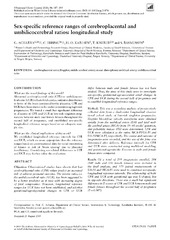| dc.contributor.author | Acharya, Ganesh | en_US |
| dc.contributor.author | Ebbing, Cathrine | en_US |
| dc.contributor.author | Karlsen, Henriette Odland | en_US |
| dc.contributor.author | Kiserud, Torvid | en_US |
| dc.contributor.author | Rasmussen, Svein | en_US |
| dc.date.accessioned | 2020-08-04T12:46:28Z | |
| dc.date.available | 2020-08-04T12:46:28Z | |
| dc.date.issued | 2020 | |
| dc.Published | Acharya G, Ebbing C, Karlsen H, Kiserud T, Rasmussen S. Sex-specific reference ranges of cerebroplacental and umbilicocerebral ratios: A longitudinal study. Ultrasound in Obstetrics and Gynecology. 2020;56:187-195 | eng |
| dc.identifier.issn | 1469-0705 | |
| dc.identifier.issn | 0960-7692 | |
| dc.identifier.uri | https://hdl.handle.net/1956/23410 | |
| dc.description.abstract | Objectives: Observational studies have shown that low cerebroplacental ratio (CPR) values predict an increased risk of adverse perinatal outcome. The inverse ratio, i.e. the umbilicocerebral ratio (UCR), has been suggested to be a better predictor as it rises with increasing degree of fetal compromise. However, longitudinal reference ranges for UCR have not been established, and whether gestational‐age‐dependent changes in CPR or UCR differ between male and female fetuses has not been studied. Thus, the aims of this study were to investigate sex‐specific, gestational‐age‐associated serial changes in CPR and UCR during the second half of pregnancy and to establish longitudinal reference ranges. Methods: This was a secondary analysis of prospectively collected data from a dual‐center longitudinal observational cohort study of low‐risk singleton pregnancies. Doppler blood‐flow velocity waveforms were obtained serially from the umbilical artery (UA) and fetal middle cerebral artery (MCA) from 19–41 weeks' gestation, and pulsatility indices (PIs) were determined. CPR and UCR were calculated as the ratios MCA‐PI/UA‐PI and UA‐PI/MCA‐PI, respectively. The course and outcome of pregnancies were recorded, and the sex of the fetus was determined after delivery. Reference intervals for CPR and UCR were constructed using multilevel modeling, and gestational‐age‐specific Z ‐scores in male and female fetuses were compared. Results: Of a total of 299 pregnancies enrolled, 284 (148 male and 136 female fetuses) were included in the final analysis, and 979 paired measurements of UA‐PI and MCA‐PI were used to construct sex‐specific longitudinal reference intervals. The relationship of both CPR and UCR with gestational age was U‐shaped, but in opposite directions. There was a small but significant difference in Z ‐scores of CPR and UCR between male and female fetuses throughout the second half of pregnancy (P = 0.007). Conclusions: We have established longitudinal reference ranges for CPR and UCR suitable for serial monitoring, with the possibility of refining assessment by using fetal sex‐specific ranges and conditioning by a previous measurement. The clinical significance of such refinements needs further evaluation. © 2019 The Authors. Ultrasound in Obstetrics & Gynecology published by John Wiley & Sons Ltd on behalf of the International Society of Ultrasound in Obstetrics and Gynecology. | en_US |
| dc.language.iso | eng | eng |
| dc.publisher | Wiley | eng |
| dc.rights | Attribution CC BY | eng |
| dc.rights.uri | http://creativecommons.org/licenses/by/4.0 | eng |
| dc.title | Sex-specific reference ranges of cerebroplacental and umbilicocerebral ratios: A longitudinal study | en_US |
| dc.type | Peer reviewed | |
| dc.type | Journal article | |
| dc.date.updated | 2020-01-13T09:13:57Z | |
| dc.description.version | publishedVersion | en_US |
| dc.rights.holder | Copyright 2019 The Author(s) | |
| dc.identifier.doi | https://doi.org/10.1002/uog.21870 | |
| dc.identifier.cristin | 1756776 | |
| dc.source.journal | Ultrasound in Obstetrics and Gynecology | |

